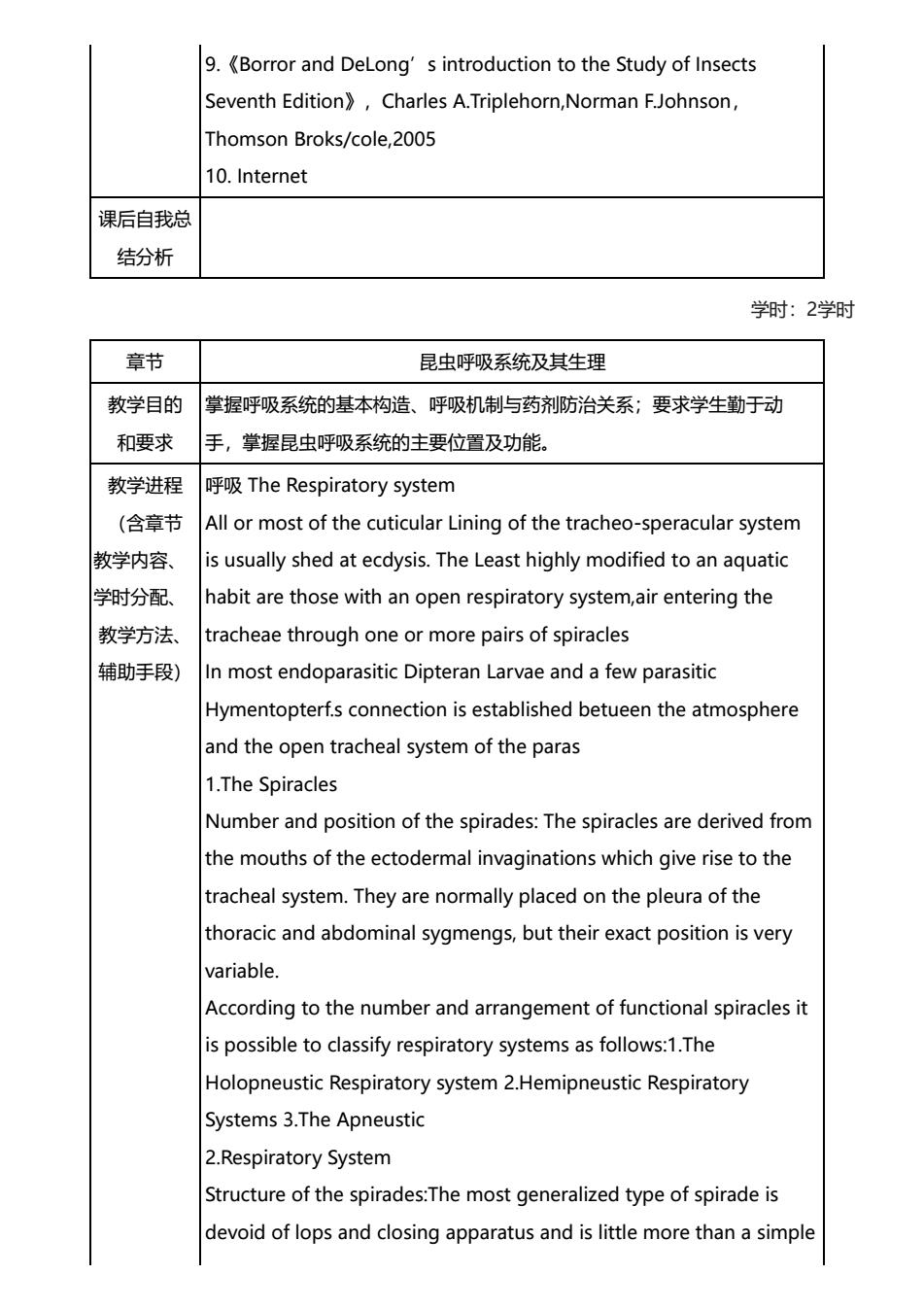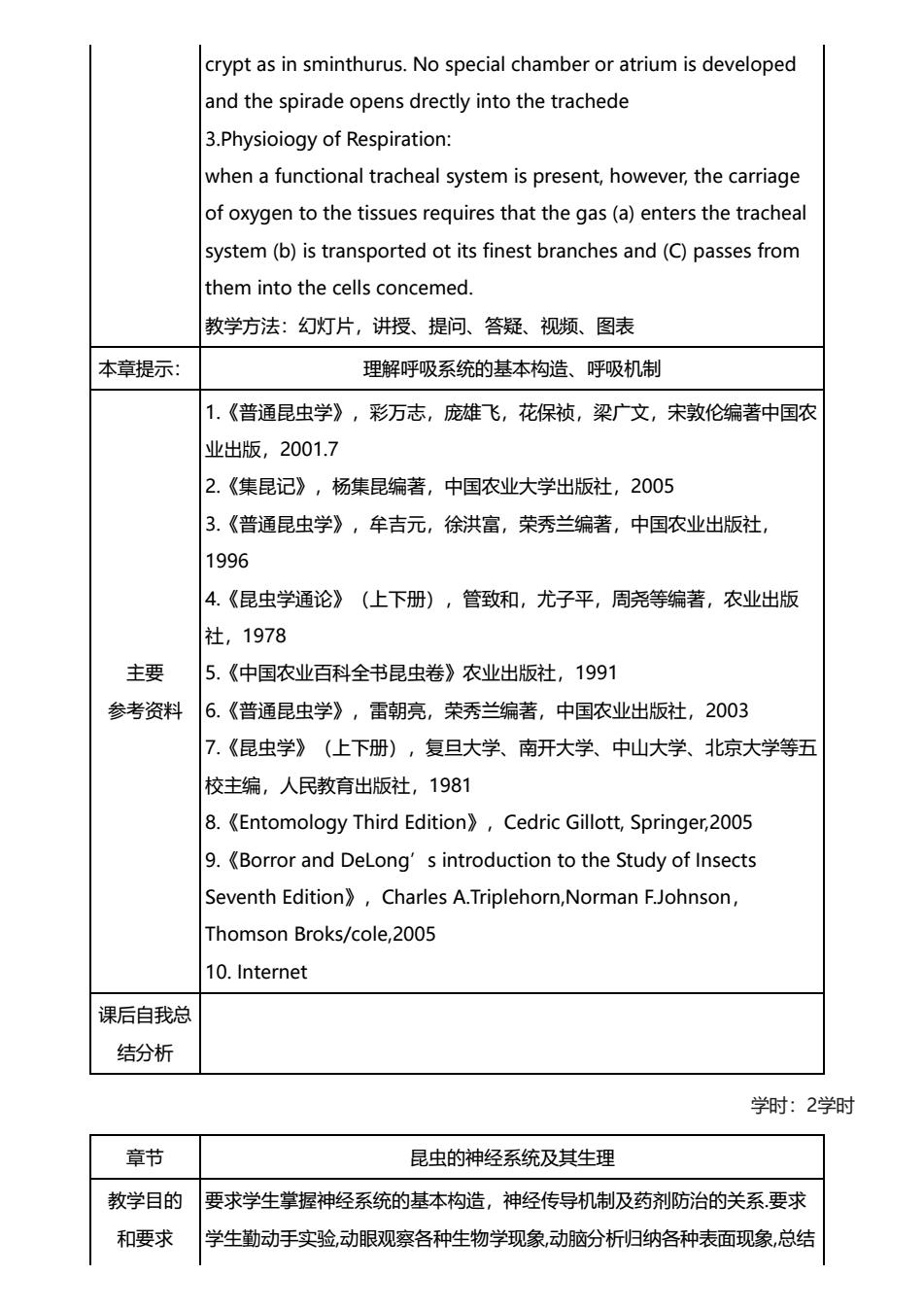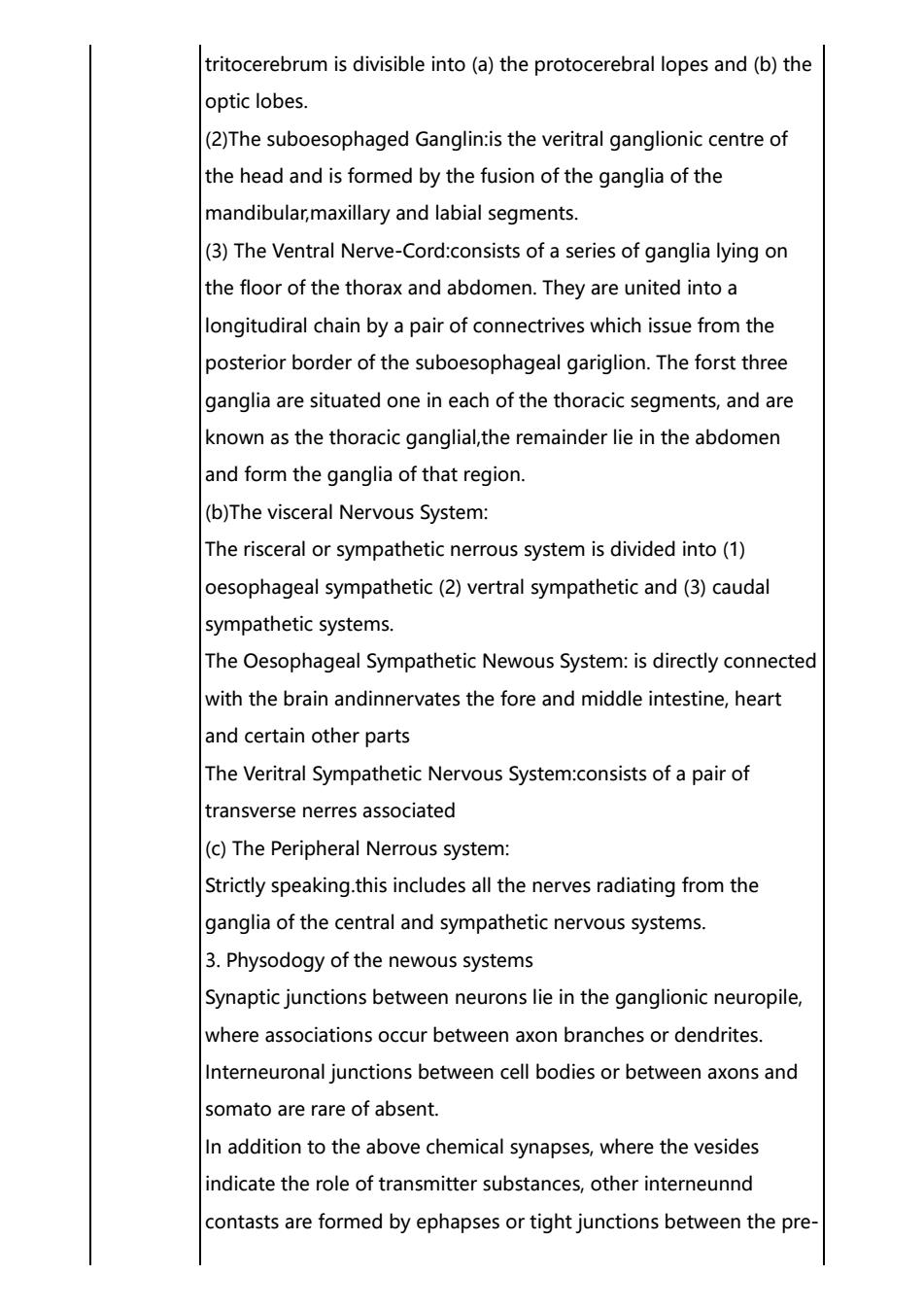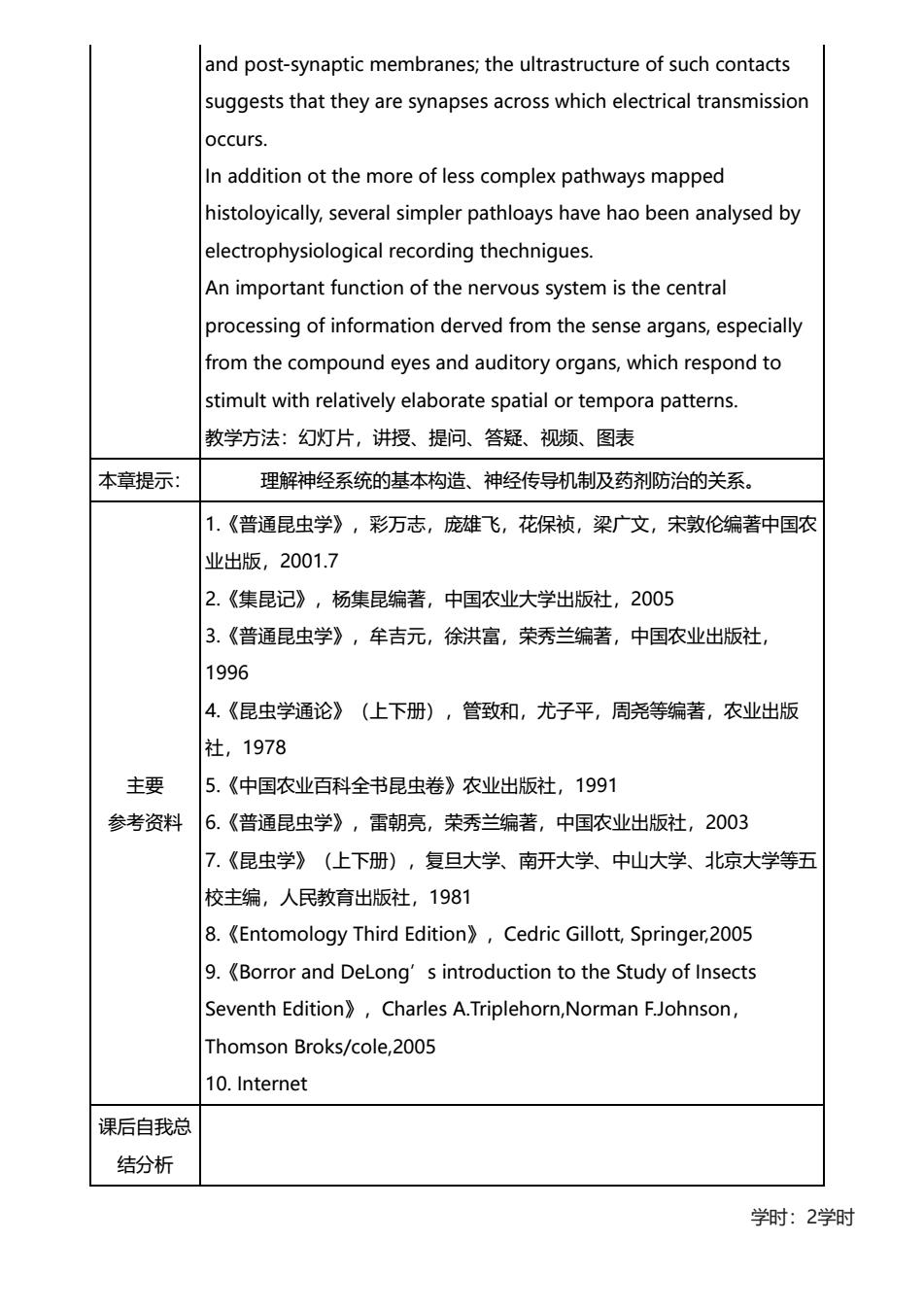
9.Borror and DeLong's introduction to the Study of Insects Seventh Edition),Charles A.Triplehorn,Norman F.Johnson, Thomson Broks/cole,2005 10.Internet 课后自我总 结分析 学时:2学时 章节 昆虫呼吸系统及其生理 教学目的 掌握呼吸系统的基本构造、呼吸机制与药剂防治关系; 要求学生勤于动 和要求 手,掌握昆虫呼吸系统的主要位置及功能。 教学进程 呼吸The Respiratory system (含章节 All or most of the cuticular Lining of the tracheo-speracular system 教学内容、 is usually shed at ecdysis.The Least highly modified to an aquatic 学时分配、 habit are those with an open respiratory system,air entering the 教学方法、 tracheae through one or more pairs of spiracles 辅助手段) In most endoparasitic Dipteran Larvae and a few parasitic Hymentopterf.s connection is established betueen the atmosphere and the open tracheal system of the paras 1.The Spiracles Number and position of the spirades:The spiracles are derived from the mouths of the ectodermal invaginations which give rise to the tracheal system.They are normally placed on the pleura of the thoracic and abdominal sygmengs,but their exact position is very variable. According to the number and arrangement of functional spiracles it is possible to classify respiratory systems as follows:1.The Holopneustic Respiratory system 2.Hemipneustic Respiratory Systems 3.The Apneustic 2.Respiratory System Structure of the spirades:The most generalized type of spirade is devoid of lops and closing apparatus and is little more than a simple
9.《Borror and DeLong’s introduction to the Study of Insects Seventh Edition》,Charles A.Triplehorn,Norman F.Johnson, Thomson Broks/cole,2005 10. Internet 课后自我总 结分析 学时:2学时 章节 昆虫呼吸系统及其生理 教学目的 和要求 掌握呼吸系统的基本构造、呼吸机制与药剂防治关系;要求学生勤于动 手,掌握昆虫呼吸系统的主要位置及功能。 教学进程 (含章节 教学内容、 学时分配、 教学方法、 辅助手段) 呼吸 The Respiratory system All or most of the cuticular Lining of the tracheo-speracular system is usually shed at ecdysis. The Least highly modified to an aquatic habit are those with an open respiratory system,air entering the tracheae through one or more pairs of spiracles In most endoparasitic Dipteran Larvae and a few parasitic Hymentopterf.s connection is established betueen the atmosphere and the open tracheal system of the paras 1.The Spiracles Number and position of the spirades: The spiracles are derived from the mouths of the ectodermal invaginations which give rise to the tracheal system. They are normally placed on the pleura of the thoracic and abdominal sygmengs, but their exact position is very variable. According to the number and arrangement of functional spiracles it is possible to classify respiratory systems as follows:1.The Holopneustic Respiratory system 2.Hemipneustic Respiratory Systems 3.The Apneustic 2.Respiratory System Structure of the spirades:The most generalized type of spirade is devoid of lops and closing apparatus and is little more than a simple

crypt as in sminthurus.No special chamber or atrium is developed and the spirade opens drectly into the trachede 3.Physioiogy of Respiration: when a functional tracheal system is present,however,the carriage of oxygen to the tissues requires that the gas(a)enters the tracheal system(b)is transported ot its finest branches and(C)passes from them into the cells concemed. 教学方法:幻灯片,讲授、提问、答疑、视频、图表 本章提示: 理解呼吸系统的基本构造、呼吸机制 1.《普通昆虫学》,彩万志,庞雄飞,花保祯,梁广文,宋敦伦编著中国农 业出版,2001.7 2.《集昆记》,杨集昆编著,中国农业大学出版社,2005 3.《普通昆虫学》,牟吉元,徐洪富,荣秀兰编著,中国农业出版社, 1996 4.《昆虫学通论》(上下册),管致和,尤子平,周尧等编著,农业出版 社,1978 主要 5.《中国农业百科全书昆虫卷》农业出版社,1991 参考资料 6.《普通昆虫学》,雷朝亮,荣秀兰编著,中国农业出版社,2003 7.《昆虫学》(上下册),复旦大学、南开大学、中山大学、北京大学等五 校主编,人民教育出版社,1981 8.Entomology Third Edition),Cedric Gillott,Springer,2005 9.Borror and DeLong's introduction to the Study of Insects Seventh Edition),Charles A.Triplehorn,Norman F.Johnson, Thomson Broks/cole,2005 10.Internet 课后自我总 结分析 学时:2学时 章节 昆虫的神经系统及其生理 教学目的 要求学生掌握神经系统的基本构造,神经传导机制及药剂防治的关系要求 和要求 学生勤动手实验,动眼观察各种生物学现象,动脑分析归纳各种表面现象,总结
crypt as in sminthurus. No special chamber or atrium is developed and the spirade opens drectly into the trachede 3.Physioiogy of Respiration: when a functional tracheal system is present, however, the carriage of oxygen to the tissues requires that the gas (a) enters the tracheal system (b) is transported ot its finest branches and (C) passes from them into the cells concemed. 教学方法:幻灯片,讲授、提问、答疑、视频、图表 本章提示: 理解呼吸系统的基本构造、呼吸机制 主要 参考资料 1.《普通昆虫学》,彩万志,庞雄飞,花保祯,梁广文,宋敦伦编著中国农 业出版,2001.7 2.《集昆记》,杨集昆编著,中国农业大学出版社,2005 3.《普通昆虫学》,牟吉元,徐洪富,荣秀兰编著,中国农业出版社, 1996 4.《昆虫学通论》(上下册),管致和,尤子平,周尧等编著,农业出版 社,1978 5.《中国农业百科全书昆虫卷》农业出版社,1991 6.《普通昆虫学》,雷朝亮,荣秀兰编著,中国农业出版社,2003 7.《昆虫学》(上下册),复旦大学、南开大学、中山大学、北京大学等五 校主编,人民教育出版社,1981 8.《Entomology Third Edition》,Cedric Gillott, Springer,2005 9.《Borror and DeLong’s introduction to the Study of Insects Seventh Edition》,Charles A.Triplehorn,Norman F.Johnson, Thomson Broks/cole,2005 10. Internet 课后自我总 结分析 学时:2学时 章节 昆虫的神经系统及其生理 教学目的 和要求 要求学生掌握神经系统的基本构造,神经传导机制及药剂防治的关系.要求 学生勤动手实验,动眼观察各种生物学现象,动脑分析归纳各种表面现象,总结

般规律 教学进程 神经The Nervous system (含章节 1 The General Nervous System 教学内容、 The nervous system is composed essentially of ramifying neuraglial 学时分配、 cells with supporting and nutritive functions and the more 教学方法 numerous neurons,which are highly specidized for the relatively 辅助手段) rapid generation and conduction of electrochemical nervous impulses Processes of each neuron put it into contact by synaptic junctions with other newe cells or with sensory structures or effector organs. One or more of those processes forms a long conducting fibre of axon ending in a group of fine,branching fibrils;the number of axons enables the neuron to be classified as uni-,bi-of nultipolar Functionally the newe cells may be sensory neurons,conveying impulses inwards from the sense organs,motor of efferent neurons that link the other two types. 2 It is convenient ot divede the insect newous system into (a)the ceritral nervous system(b)the visceral newous system.And(c)the peripheral nervous systern,all three parts being connected with each other. (a)The central Nervous System: This is the principal division of the nervous system and consists of a double series of ganglia joined by longitudinal and transverse strunds of newe fibres The central nervous system is divisible into the brain of cerebral ganglion,the suboesophageal ganglion and the ventral newe-cord. (1)The Brain:lies just above the oesophagus between the supporting apodemes of the tentoriam. It is formed by the coalescence of the first three neuromeris in the embrgo.This threefold division is maintained in the completed organ which is divided into corresponding regions which are designated the protocerebrum.The deutoroebnum and the
一般规律. 教学进程 (含章节 教学内容、 学时分配、 教学方法、 辅助手段) 神经 The Nervous system 1 The General Nervous System The nervous system is composed essentially of ramifying neuraglial cells with supporting and nutritive functions and the more numerous neurons, which are highly specidized for the relatively rapid generation and conduction of electrochemical nervous impulses Processes of each neuron put it into contact by synaptic junctions with other newe cells or with sensory structures or effector organs. One or more of those processes forms a long conducting fibre of axon ending in a group of fine, branching fibrils;the number of axons enables the neuron to be classified as uni-, bi- of nultipolar Functionally the newe cells may be sensory neurons, conveying impulses inwards from the sense organs, motor of efferent neurons that link the other two types. 2 It is convenient ot divede the insect newous system into (a) the ceritral nervous system (b) the visceral newous system. And (c) the peripheral nervous systern, all three parts being connected with each other. (a) The central Nervous System: This is the principal division of the nervous system and consists of a double series of ganglia joined by longitudinal and transverse strunds of newe fibres The central nervous system is divisible into the brain of cerebral ganglion,the suboesophageal ganglion and the ventral newe-cord. (1)The Brain:lies just above the oesophagus between the supporting apodemes of the tentoriam. It is formed by the coalescence of the first three neuromeris in the embrgo. This threefold division is maintained in the completed organ which is divided into corresponding regions which are designated the protocerebrum. The deutoroebnum and the

tritocerebrum is divisible into(a)the protocerebral lopes and(b)the optic lobes. (2)The suboesophaged Ganglin:is the veritral ganglionic centre of the head and is formed by the fusion of the ganglia of the mandibular,maxillary and labial segments. (3)The Ventral Nerve-Cord:consists of a series of ganglia lying on the floor of the thorax and abdomen.They are united into a longitudiral chain by a pair of connectrives which issue from the posterior border of the suboesophageal gariglion.The forst three ganglia are situated one in each of the thoracic segments,and are known as the thoracic ganglial,the remainder lie in the abdomen and form the ganglia of that region. (b)The visceral Nervous System: The risceral or sympathetic nerrous system is divided into(1) oesophageal sympathetic(2)vertral sympathetic and(3)caudal sympathetic systems. The Oesophageal Sympathetic Newous System:is directly connected with the brain andinnervates the fore and middle intestine,heart and certain other parts The Veritral Sympathetic Nervous System:consists of a pair of transverse nerres associated (c)The Peripheral Nerrous system: Strictly speaking.this includes all the nerves radiating from the ganglia of the central and sympathetic nervous systems. 3.Physodogy of the newous systems Synaptic junctions between neurons lie in the ganglionic neuropile, where associations occur between axon branches or dendrites. Interneuronal junctions between cell bodies or between axons and somato are rare of absent. In addition to the above chemical synapses,where the vesides indicate the role of transmitter substances,other interneunnd contasts are formed by ephapses or tight junctions between the pre-
tritocerebrum is divisible into (a) the protocerebral lopes and (b) the optic lobes. (2)The suboesophaged Ganglin:is the veritral ganglionic centre of the head and is formed by the fusion of the ganglia of the mandibular,maxillary and labial segments. (3) The Ventral Nerve-Cord:consists of a series of ganglia lying on the floor of the thorax and abdomen. They are united into a longitudiral chain by a pair of connectrives which issue from the posterior border of the suboesophageal gariglion. The forst three ganglia are situated one in each of the thoracic segments, and are known as the thoracic ganglial,the remainder lie in the abdomen and form the ganglia of that region. (b)The visceral Nervous System: The risceral or sympathetic nerrous system is divided into (1) oesophageal sympathetic (2) vertral sympathetic and (3) caudal sympathetic systems. The Oesophageal Sympathetic Newous System: is directly connected with the brain andinnervates the fore and middle intestine, heart and certain other parts The Veritral Sympathetic Nervous System:consists of a pair of transverse nerres associated (c) The Peripheral Nerrous system: Strictly speaking.this includes all the nerves radiating from the ganglia of the central and sympathetic nervous systems. 3. Physodogy of the newous systems Synaptic junctions between neurons lie in the ganglionic neuropile, where associations occur between axon branches or dendrites. Interneuronal junctions between cell bodies or between axons and somato are rare of absent. In addition to the above chemical synapses, where the vesides indicate the role of transmitter substances, other interneunnd contasts are formed by ephapses or tight junctions between the pre-

and post-synaptic membranes;the ultrastructure of such contacts suggests that they are synapses across which electrical transmission occurs. In addition ot the more of less complex pathways mapped histoloyically,several simpler pathloays have hao been analysed by electrophysiological recording thechnigues. An important function of the nervous system is the central processing of information derved from the sense argans,especially from the compound eyes and auditory organs,which respond to stimult with relatively elaborate spatial or tempora patterns. 教学方法:幻灯片,讲授、提问、答疑、视频、图表 本章提示: 理解神经系统的基本构造、神经传导机制及药剂防治的关系。 1.《普通昆虫学》,彩万志,庞雄飞,花保祯,梁广文,宋敦伦编著中国农 业出版,2001.7 2.《集昆记》,杨集昆编著,中国农业大学出版社,2005 3.《普通昆虫学》,牟吉元,徐洪富,荣秀兰编著,中国农业出版社, 1996 4.《昆虫学通论》(上下册),管致和,尤子平,周尧等编著,农业出版 社,1978 主要 5.《中国农业百科全书昆虫卷》农业出版社,1991 参考资料 6.《普通昆虫学》,雷朝亮,荣秀兰编著,中国农业出版社,2003 7.《昆虫学》(上下册),复旦大学、南开大学、中山大学、北京大学等五 校主编,人民教育出版社,1981 8.Entomology Third Edition),Cedric Gillott,Springer,2005 9.Borror and DeLong's introduction to the Study of Insects Seventh Edition),Charles A.Triplehorn,Norman F.Johnson, Thomson Broks/cole,2005 10.Internet 课后自我总 结分析 学时:2学时
and post-synaptic membranes; the ultrastructure of such contacts suggests that they are synapses across which electrical transmission occurs. In addition ot the more of less complex pathways mapped histoloyically, several simpler pathloays have hao been analysed by electrophysiological recording thechnigues. An important function of the nervous system is the central processing of information derved from the sense argans, especially from the compound eyes and auditory organs, which respond to stimult with relatively elaborate spatial or tempora patterns. 教学方法:幻灯片,讲授、提问、答疑、视频、图表 本章提示: 理解神经系统的基本构造、神经传导机制及药剂防治的关系。 主要 参考资料 1.《普通昆虫学》,彩万志,庞雄飞,花保祯,梁广文,宋敦伦编著中国农 业出版,2001.7 2.《集昆记》,杨集昆编著,中国农业大学出版社,2005 3.《普通昆虫学》,牟吉元,徐洪富,荣秀兰编著,中国农业出版社, 1996 4.《昆虫学通论》(上下册),管致和,尤子平,周尧等编著,农业出版 社,1978 5.《中国农业百科全书昆虫卷》农业出版社,1991 6.《普通昆虫学》,雷朝亮,荣秀兰编著,中国农业出版社,2003 7.《昆虫学》(上下册),复旦大学、南开大学、中山大学、北京大学等五 校主编,人民教育出版社,1981 8.《Entomology Third Edition》,Cedric Gillott, Springer,2005 9.《Borror and DeLong’s introduction to the Study of Insects Seventh Edition》,Charles A.Triplehorn,Norman F.Johnson, Thomson Broks/cole,2005 10. Internet 课后自我总 结分析 学时:2学时